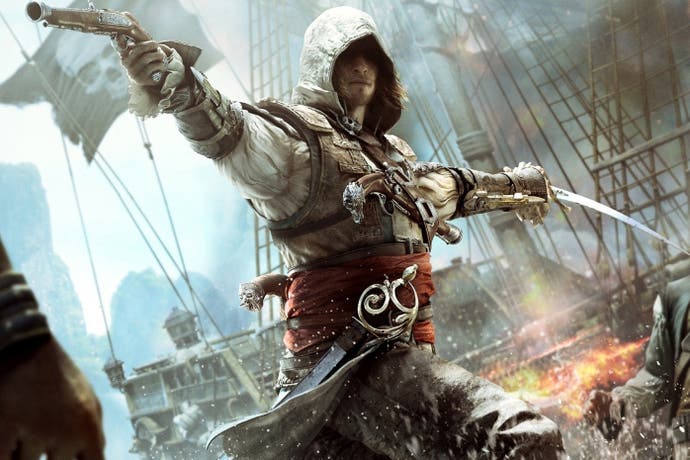Tech Analysis: Assassin's Creed 4
Digital Foundry assesses the next-gen difference.
Six releases of one game from eight studios, all within a month. Credit must be given where it's due, Ubisoft is certainly keeping its arms wide open to owners of every format with the launch of its stealthy swashbuckler, Assassin's Creed 4: Black Flag. To our count we have versions on PC, Wii U, Xbox 360, Xbox One, PS3 and PS4 all etched in for a busy November - a similar case for Watch Dogs' debut that same month. It's a cross-gen project on a scale we've rarely seen before, though surprisingly, principle development only started at Ubisoft Montreal around mid-2011. For such a grand effort this hasn't been much time at all, meaning satellite studios in Kiev, Montpelier, Sofia, Singapore, and Quebec have been tasked with aiding the design of the single-player mode, while offices in Bucharest and Annecy take charge of its multiplayer portions.
Quite a few cooks circling the broth, then. Based on the game's stop-starting live demo at Sony's E3 conference last month, there is a justified concern that Ubisoft's divided attention might not be doing any favours for unleashing the true next-gen potential in the PS4 and Xbox One versions. The demo is no doubt impressive, taking us from a piratical stupor on the Caribbean beaches to a jungle sneaking mission, and then closing with a pyrotechnic ship battle as our anti-hero, Edward Kenway, takes charge of his Jackdaw frigate. The question is: can a cross-gen game of this kind give us a fair example of what these new consoles bring to the table?
Based on our guided demonstration of the game at E3 - the same demo as shown during the conference, as controlled by a Ubisoft rep - there's plenty going on here to make a case for the premium price-tags of next-gen hardware, though the drawbacks of multi-platform development do creep in. To start, environmental design appears closer in tone to that of Far Cry 3's, and makes for a great example of how loading screens have been cut out of the equation when transitioning from on-foot stealth in jungles to navigating the seas. What appears to be a push for 1080p native resolution can't be faulted by the naked eye here either, though this crisp presentation lays bare some assets which clearly belong to the previous generation.
"Assassin's Creed 4 makes the case for the premium price-tag of next-gen hardware, though the drawbacks of cross-generation development do creep in."
For the sake of keeping development streamlined across the six chosen formats, it's understandable that the quality of some geometry will be comparable to Assassin's Creed 3 on PS3 and 360 in spots. It's the case for the rigid, angular masts and ropes that detail ships during the battle across the West Indies coasts, and the crude, blurry fire effects as Edward runs through the besieged docks. Even so, Ubisoft has committed its time towards areas which might be better noticed, such as the modelling detail on major characters like Blackbeard, and the game's lush jungles environments. Both of these fall in line with the very high presets for environmental and texture settings seen on the PC version of Assassin's Creed 3, though more variety is afforded here thanks to the more complex nature of the setting.
By virtue of being set across the more organic 18th century Caribbean islands, Black Flag marries its jungle environments with naval warfare and city exploration - instantly making it more vibrant spectacle than the foggy Boston streets of the last game. The studio's token AnvilNext engine fleshes this premise out in full for each version by adding a new vegetation system to realise dense swathes of forestry, plus ambient wildlife such as crabs, iguanas and seagulls, which can be hunted. Recent walkthroughs of the game by the game's director, Ashraf Ismail, make it clear that Ubisoft's designers have taken far greater artistic license when putting together this world, this time plotting out Mayan ruins, underwater shipwrecks, and smuggler's coves between each major city. And thankfully, there's no sign of level-of-detail scaling during the demos we've seen, even from the dizzying heights of some sync points.
While this seamless, loading-screen free world is a feature on all platforms, the next-gen versions distinguish themselves through more precise physics for vegetation and waves. Ferns bend and wobble back to a default position as Edward sneaks through, while on current-gen versions, Ismail informs Eurogamer that "it either doesn't react or it plays an animation." He also cites the fog, heat effects and overall density of jungle areas as crucial areas of evolution over the PS3 and 360 versions - though it remains to be seen where on the spectrum the Wii U version lies. Overhauled water physics also play into the promise of a 60-40 per cent balance between land and sea adventuring, with water spouts and wind direction affecting the outcome of battles on the tides.
"Light-shafts have been added to the visual mix... the sense of the musty, gunpowder polluted air during naval battles is underscored as light trails come streaming through the rip-holes of oncoming enemy sails."
Effects work is also as crisp as we've seen in some first-party PS4 software, such as the gorgeous embers and sparks spewing from Deslin in Infamous: Second Son. The billows of smoke rising from the cracks in the ship's deck, the tall splashes as warring ships collide, and puffs of gunpowder from our hero's Flintlock pistols show off vastly smoother, higher resolution alpha buffers than anything seen on recent PC entries in the series. The only downside is the easily perceptible repetition to the patterning as some line up in a sequence. Equally, there's a sense that Ubisoft is holding back on some the more advanced visual tricks seen in other action titles like God of War, such as motion blur of any capacity.
As is the trend these days, light-shafts are added to the visual mix - and to very practical effect in this case. The sense of the musty, gunpowder polluted air during naval battles is underscored as light trails come streaming through the rip-holes of oncoming enemy sails. It also helps to illustrate the dense, thick atmosphere of jungle areas, where portable lamps reflect against ferns as each flops and bends around passing characters. Sadly, skin shaders on characters themselves don't show much of an advance above previous games, and animations appear largely unchanged. The methodical parkour movements, in effect, have evolved little since the last game, though new combat animations are added for stringing strikes from four pistols and two cutlasses.
On a performance level, yet again it's a shame to see the opportunity for 60fps pass us by on next-gen, but at least we have what's shaping up to be a solid 30fps game on our hands. Gone is the tearing of Assassin's Creed 1 and 2, and similarly the sustained drops to the 20fps mark in the third game on console isn't a factor here.
"Our early analysis based on the presentation given at the Sony E3 event gives a result that appears locked for the most part in the 30fps range, with absolutely no tearing."
Our early analysis based on the presentation given at the Sony E3 presentation gives a result that appears locked for the most part in the 30fps range, with absolutely no tearing. The only genuine dips in frame-rate come at the end of the demo, in fact, as a result of cannon-fire to the deck of the Jackdaw which lowers it to 20fps for split-seconds. Of course, those six nail-biting hangs in performance from the conference demo are present in the performance analysis too. It's an unfortunate reality of live demonstrations, though it must be said that these didn't appear in any form during our private demo of the game with Ubisoft, which featured the very same sequence.
Overall, the cross-gen period gives us a rare chance to get some idea of the technical strengths of each platform directly using a single game, and it will be fascinating to compare the close-to-maxed-out current-gen builds with launch period work on Xbox One and PS4. However, for now the PS3, Xbox 360 and Wii U versions of Assassin's Creed 4 remain shrouded in mystery. If we're to use the series' third numbered entry on PS3 and 360 as an anchor point in this comparison, both the PS4 and Xbox One versions are set to go beyond Ubisoft's usual extra flourishes with its PC releases by adding a more precise physics model for vegetation and water, sharper effects, plus greater density to environmental details. It's a clear step up in the visual stakes, and meets the challenge of realising a beautiful Caribbean setting that stretches out for miles on end.
However, this is ultimately extra gloss running over the top of a matching core experience, albeit with a smoother frame-rate and higher resolution than we can expect from current-gen versions. More radical overhauls to Assassin's Creed's design may only come further on down the line, once Ubisoft is ready to do away with the current-gen's mammoth install base, with the baseline limitations the older hardware imposes on the game design. In the meantime, we'll have to wait until the launch dates of Sony and Microsoft's next-gen platforms to see the contrasts in full, and whether the results are indeed a closer contest for the delayed PC version. As multi-format releases go, this will be a true test of Ubisoft's ability to juggle an international spread of studios, and we daresay for whoever within Digital Foundry is on task to play all six versions nearer the time.










